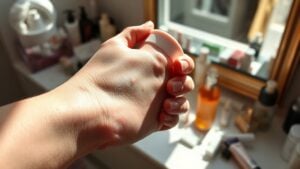Ever pondered why your deodorant seems to let you down by midday? You could be making simple mistakes without even realizing it. From applying it at the wrong time to using the wrong type for your skin, these slip-ups can leave you less protected than you believe. Whether you’re layering it over old product or skipping days, small changes could make a big difference—so let’s get into what you could be doing wrong.
Not Knowing the Difference Between Deodorant and Antiperspirant
Do you know what you’re actually putting under your arms each morning? Should you grab a deodorant believing it’ll stop sweat, you could be disappointed.
Deodorants neutralize body odor by fighting bacteria, but they don’t block sweat. Antiperspirants, on the other hand, contain aluminum salts that temporarily plug sweat glands, reducing excessive sweating by about 20%.
In case you’re handling heavy perspiration, antiperspirants are more effective. But should odor’s your main concern, a deodorant does the trick. Mixing them up means unmet expectations—like expecting dryness but still feeling damp.
Comprehending the difference boosts your personal care game. Check labels for product awareness, so you pick what works best for your needs. It’s a small step that makes a big difference in staying fresh.
Applying Deodorant Right After Shaving
Should you’ve ever slapped on deodorant right after shaving, you could have noticed your underarms burning or turning red—and there’s a good reason for that. Shaving creates tiny nicks and opens pores, making skin more vulnerable to irritation from deodorant ingredients like alcohol or fragrance. For sensitive skin, this combo can sting or trigger redness. Instead, wait at least 30 minutes post-shave to apply deodorant, letting your skin heal.
| Mistake | Better Choice |
|---|---|
| Applying immediately | Waiting 30 minutes post-shave |
| High-alcohol deodorants | Fragrance-free, soothing formulas |
| Ignoring irritation | Using post-shave calming products |
Opt for fragrance-free or alcohol-free deodorants should your skin react easily. Should you need coverage right away, try a gentle, post-shave soothing alternative like aloe gel. Your underarms will thank you.
Layering Deodorant on Top of Old Product
Even should you be in a rush, slapping deodorant over yesterday’s leftover layer could seem harmless—but it’s a fast track to weaker odor protection and sticky buildup. Layering fresh application on old product traps residue, reducing effectiveness and increasing irritation. Here’s why you should skip the shortcut:
- Blocks Adhesion: Old product creates a barrier, stopping new deodorant from bonding to clean skin.
- Mixes Scents: Layering different formulas can clash, leaving an odd fragrance instead of fresh confidence.
- Triggers Irritation: Buildup clogs pores, raising the risk of redness or discomfort.
- Wastes Product: You’ll use more to feel protected, but it won’t work as well.
Always wash and dry skin before applying to guarantee maximum comfort and performance. A quick wipe-down makes all the difference.
Applying Deodorant in the Morning Instead of at Night
Applying deodorant right before heading out could feel like the obvious move, but timing matters more than you’d consider. Your sweat ducts are less active at night, so evening application lets the product absorb better for extended protection. Once you apply it to clean, dry skin before bed, it forms a barrier against odor and sweat without moisture interference the next day.
| Morning | Night | Why It Matters |
|---|---|---|
| Sweat ducts active | Sweat ducts quiet | Better absorption |
| Moisture interferes | Skin stays dry | Reliable odor control |
| Short-term results | Lasts all day | Extended protection |
| Easy to forget | Builds a routine | Consistent nighttime application |
| Less effective | More effective | Stronger protection against odor |
Switching to nighttime application boosts your regular routine and keeps you fresh longer.
Skipping Deodorant Application Daily
Many people don’t realize that skipping deodorant even once can throw off your body’s natural balance.
Daily application is key to controlling body odor and keeping bacteria in check, especially in your underarms. Here’s why consistency matters:
- Bacteria buildup: Skipping deodorant lets sweat mix with bacteria, creating unpleasant smells.
- Skin health: Regular use prevents irritation by reducing moisture and friction from sweating.
- Antiperspirant effectiveness: Some formulas work best at the time of application daily, blocking sweat before it starts.
- Confidence boost: Staying fresh avoids awkward moments and keeps you comfortable all day.
Your underarms need attention just like the rest of your skin.
Missing a day could seem harmless, but it can lead to bigger issues.
Stick to a routine—your body (and those around you) will thank you.
Forgetting to Moisturize Underarms
Dry, irritated underarms aren’t just uncomfortable—they can make your deodorant less effective, too. Forgetting to moisturize leads to dry skin, which can increase irritation and reduce how well your deodorant works.
Well-hydrated underarms help boost adhesion, so your product lasts longer. Try moisturizing lotions with gentle ingredients or natural alternatives like coconut oil to soothe and protect your skin.
It’s simple: healthy, hydrated skin means better performance from your deodorant and fewer problems like redness or itching. Make moisturizing part of your daily hygiene routine—your underarms deserve the same care as the rest of your body.
Plus, keeping your skin in good shape improves effectiveness by preventing flakes or dryness that can interfere with application. A little effort goes a long way for skin health.
Using the Wrong Product for Your Skin Type
- Know your skin type: Should you have sensitive skin, avoid high alcohol content or heavily scented formulas.
- Look for gentle options: Choose fragrance-free or products with moisturizing benefits to soothe dryness.
- Do a patch test: Apply a small amount to check for irritation before full use.
- Read labels: Skip harsh ingredients should your skin react easily.
Using the wrong product can make things worse, so pay attention to what your skin needs.


